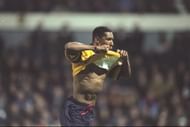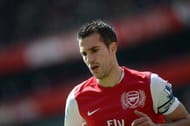Arsène Wenger has forever been in the mix of the transfer market, using his elite scouting network to scour the plains and the hills for the best of talent at the lowest of prices. His ability to find gems in deep dark coal mines is peerless. He’s infamously stingy when it comes to spending the big bucks, but that doesn’t necessarily mean he’s a bad businessman. Lots of questions have been raised at him being more of a businessman as opposed to a football manager, but given the debt Arsenal were under after the move from Highbury to the Emirates, his outlook towards the balance sheet is slowly gaining appreciation, if not blatant glee. Arsenal are now quickly moving towards a debt-free structure, in addition to a squad that is not short of world-class. Let’s take a look at the top signings of Arsène Wenger. But do keep in mind that they aren’t in any particular order, as quantifying talent with regard to the money spent on them will dilute their legacy at the club.
Kolo Touré
In: £1,50,000 Out: £16 million
The Ivory Coast defender joined Arsenal in the February of 2002 from ASEC Mimosas, an Ivorian football club based in Abidjan, for a fee of £150,000. In the following seven seasons for the Gunners, Touré played 225 games, leaving his mark on the Arsenal back line, especially during the 2003-04 season, when Arsenal remained undefeated. Alongside Sol Campbell, Touré stuck it out in central defence in spite of having played as a striker and an attacking midfielder.
Touré earned the number 5 shirt after Martin Keown’s retirement, eventually captaining the team on multiple occasions. Touré also helped his side reach the 2006 Champions League final with the sole goal against Villareal over the two legs. It also became the last European goal scored at Highbury. His partnership with Senderos saw him up the ante even further after Arsenal held on to 10 consecutive clean sheets – a European competition record. Eventually sold to Manchester City for £16 million, Touré was one of the best buys by Arsène Wenger, and also demonstrated how the Frenchman can not only uncover talent, but nurture it too.
Fredrik Ljungberg
In: £3m Out: £3m
“We love you Freddie, cuz you’ve got red hair
We love you Freddie, cuz you’re everywhere.”
One of the many talismanic players to have played under Wenger, the Swedish footballer was a gem. He took the plunge in 1998, when he signed from Halmstads BK for £3 million. The amount made it the maximum amount paid for a Swedish player at that time. Arsène Wenger, renowned for his meticulous assessment of talent, skipped a few steps after he decided to sign Ljungberg after watching him play in Sweden’s victory against England on television. Ljungberg hit the ground running, scoring on debut against Manchester United, and helping Arsenal win the game 3-0.
Over the next nine seasons, the player accumulated 216 games, scoring 46 times. Comfortable on either wing, Ljungberg could play as an attacking midfielder and double up as a supporting striker. After the departure of Emmanuel Petit and Marc Overmars, he found a permanent spot in the first team. In Arsenal.com’s List of Greatest 50 Players, the Swede came in 11th.
The Calvin Klein underwear model was a huge hit with advertisers, representing Nike, P&G, L’Oreal, Puma, ESPN and Pepsi. He was also named the sexiest player in the Premier League at one point in time.
Ljungberg left Arsenal for West Ham United in 2007 for £3 million. Another one of Wenger’s smart buys.
Nicolas Anelka
In: £500k Out: £22.5 million
One of the many players in the Arsenal squad who were of French origin, Anelka was picked up from Paris Saint-Germain’s youth squad, at the age of 16. Bought for £500k by the newly-appointed Wenger, his potential as a striker was huge. After waiting on the sidelines for his first year, Anelka quickly found his feet, scoring his first against Manchester United in a 3-2 win at home.
He played a vital role in the double that year, scoring a decent 9 goals in 40 appearances in all competitions, but he quickly became persona non grata due to reported lack of enthusiasm and a negative attitude. The fans named him ‘Le Sulk’, and he left the following summer for Real Madrid for £22.5 million. Persistence and consistency are the last words you will choose to describe the man, as he has since been a part of 9 different clubs. He wasn’t the best buy in terms of the goals he scored; but in terms of cold hard cash, this was a brilliant bargain. Also, do keep in mind that Wenger was quick to get rid of a player who proved his critics right with his antics on and off the field. He was a talented player for sure, but certainly not the best example for his teammates.
Cesc Fabregas
In: £500k Out: £35 million
Probably the best mix of talent, temperament and class, Cesc Fabregas was an idol for youngsters around the world. Thrust in to the limelight at the age of 16, he quickly became the spine of the team. Picked up from the Barcelona youth academy, he came cheap at £500k. Already a prolific scorer for his old team, he took a bit of teething before he dug his feet in. But once he got going, there was no force stronger than a rampaging Arsenal midfield.
His prowess has been validated by the numerous awards he’s bagged over the years at Arsenal. He won the Premier League Player of the Month (January 2007, September 2007), PFA Young Player of the Year (2007–08) and was a part of the UEFA Team of the Year (2006, 2008) and PFA Team of the Year (2007–08, 2009–10). All this and more, even before he was 25.
Fabregas picked up the number 4 jersey after Vieira left for Juventus, and dispelled the initial doubts that he was no match for his predecessor in terms of strength and aggression. Fabregas brought the midfield together, threading passes and putting defenders to shame. In 2008, Fabregas finally took upon himself the responsibility of captaincy. He suffered an injury right when Arsenal were looking bright, and was out for four months.
In the year of 2011, Fabregas figuratively put his foot down and requested to head home to Barcelona. The ensuing deal was reported to be in the region of £35 million. A clear contrast to Anelka in terms of attitude, he was even better in terms of the money that eventually trickled in. In clear accounting terms, this was a ‘high return investment’.
In: £2.75 million Out: £24 million
Picked up from Feyenoord at the age of 21, Wenger got a bargain after he paid just over half the asking price of £ 5 million. The Frenchman planned to convert RvP into a central striker rather than a winger, which he had achieved with Thierry Henry in the past. He spent some time on the bench, but he quickly blossomed in to a lethal striker with a venomous left foot. In spite of his injuries which pegged him down often, he was able to play 277 games for the club, scoring 132 times in all competitions.
After Fabregas left for Barcelona, van Persie wore the captain’s armband, and the promotion seemed to add to his valour. In that season, 2011-12, van Persie single-handedly dragged Arsenal up to fourth position in the English Premier League – the last spot for the UEFA Champions League. He scored a record 30 goals in 38 Premier League games, becoming the top scorer in the league and the 8th all-time top scorer for Arsenal with 132 goals.
He left for greener pastures and signed with arch-rivals Manchester United for an initial £22.5 million, with an additional £1.5 million in variables. He was one of the most important players Arsenal have seen in the last decade or so simply because of his ability to lead, to perform and take the club up a notch.
Thierry Henry
In: £11 million Out: £16 million
The player, who was reportedly unhappy in Italy, was shown the escape hatch by Wenger. Picked up from Juventus after just one season, Henry was back with Wenger after they had worked together at Monaco. Wenger was always of the opinion that Henry was better suited to be a striker, but played him on the wing simply because his pace and game sense was better employed on the flank as opposed to a central role.
Henry was a replacement for the outgoing Anelka, and he was now in a central rol – a clear contrast to Wenger’s belief a few years back. Initially he struggled, admitting he had to ‘be re-taught everything about the art of striking.’ After the first lean patch, he went on to finish the season with 26 goals in 47 games in all competitions.
Henry quickly transformed into the team mascot, ripping teams apart with his prolific scoring and sublime touches. From dead ball situations to back heels, he left keepers pawing the air. His tally at Arsenal was 228 goals in 369 appearances, pushing him up to third in the list of all-time Premier League goal-scorers, pipped only by Alan Shearer and Andy Cole.
He is also the only player ever to have been awarded the FWA Footballer of the Year three times (2003, 2004, and 2006). He was the top scorer in the league for four seasons, (2002, 2004, 2005, and 2006) and in 2006 he became the first player ever to net over 20 goals in the English Premier League for 5 consecutive seasons (2002 to 2006).
In 2006, Henry declared that he loved the club and would stay at Arsenal for the rest of his life, and Arsenal reportedly turned down multiple bids of over £50 million, which would have pipped the transfer fee paid for Zinedine Zidane, which stood at £47 million.
In 2007, against the proverbial run of play, Henry was bought by Barcelona for £16 million. Henry has since been extremely vocal about his love for his former club, even returning on loan in the MLS off-season and bagging two winners against Sunderland and Leeds United. His goals are still the talk of the internet, like the solo winner against Real Madrid and the wonder goal against Manchester United. In 2011, Arsenal unveiled a bronze trophy of the player as a tribute to his contribution to the club. Even though his later years with Arsenal were marred by death stares and injuries, Henry never stopped being the heartbeat of the Arsenal fan. Every now and then, when we spot Henry playing a spectator in an Arsenal fixture, we can only sigh and hope for more of him. Certainly the player that defined most of Arsenal’s last decade, and probably Wenger’s best buy.
A few honorable mentions include Patrick Vieira, Sol Campbell, Gilberto Silva and Robert Pires.





